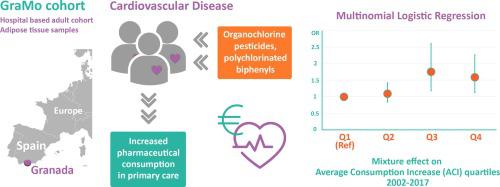Environment International ( IF 11.8 ) Pub Date : 2021-07-02 , DOI: 10.1016/j.envint.2021.106734 Francisco Miguel Pérez-Carrascosa 1 , Celia Gómez-Peña 2 , Ruth Echeverría 3 , José Juan Jiménez Moleón 4 , Juan Manuel Melchor 5 , Antonio García-Ruiz 6 , José Luis Navarro-Espigares 7 , José Cabeza-Barrera 2 , Piedad Martin-Olmedo 8 , Juan Carlos Ortigosa-García 9 , Juan Pedro Arrebola 4

|
Background
Despite restrictions on their production and use, most of the population is still exposed to Persistent Organic Pollutants (POPs), including organochlorine pesticides (OCPs) and polychlorinated biphenyls (PCBs). These chemicals are thought to contribute to the aetiology of highly prevalent chronic conditions, such as cardiovascular diseases (CVDs), although current evidences are still controversial.
Objectives
To explore the potential contribution of historical POP exposure to 15-year pharmaceutical consumption in relation to CVD.
Methods
This study is framed within GraMo adult cohort. Participants (n = 387) were recruited in two hospitals in Granada province, Southern Spain (2003–2004). Historical exposure to 5 OCPs and 3 non-dioxine-like PCBs was estimated by analysing adipose tissue concentrations at recruitment. Pharmaceutical consumption from recruitment until year 2017 was quantified by reviewing dispensation databases. Average consumption increase (ACI) in CVD medication was calculated by subtracting average consumption in 2002 to the average yearly consumption during follow-up. ACI was expressed as Defined Daily Dose (DDD)/year units. Data analyses were carried out using a multivariable multinomial logistic regression and weighted quantile sum regression (WQS), with ACI categorized in quartiles (Q) as the dependent variable.
Results
Concentrations of most pollutants showed a positive trend with the quartiles of ACI. Particularly, PCB-153 showed increasing and statistically significant odds ratios (ORs) for Q2 (OR: 1.27, 95% confidence interval (CI): 1.07–1.52), Q3 (OR: 1.49, 95 %CI: 1.17–1.88) and Q4 (OR: 1.42, 95 %CI: 1.13–1.78) vs Q1. Similarly, beta-hexachlorocyclohexane (β-HCH) also showed increasing ORs, that reached statistical significance in Q4 (OR: 1.36, 95 %CI: 1.06–1.74) vs Q1. These findings were corroborated by WQS analyses, that revealed a significant mixture effect, predominantly accounted for by PCB-153 and β-HCH.
Discussion
Our results suggest that long-term POP exposure might represent a modifiable risk factor for CVD. These findings are relevant for public health campaigns and management, since pharmaceutical consumption is considered an indicator of both morbidity and health expenditure.
中文翻译:

持久性有机污染物和心血管疾病的历史暴露:一项为期 15 年的纵向分析,重点关注初级保健中的药物消费
背景
尽管它们的生产和使用受到限制,但大多数人口仍然暴露于持久性有机污染物 (POPs),包括有机氯农药 (OCPs) 和多氯联苯 (PCBs)。这些化学物质被认为是导致高度流行的慢性病的病因,例如心血管疾病 (CVDs),尽管目前的证据仍然存在争议。
目标
探索历史 POP 暴露对 15 年药品消费与 CVD 相关的潜在贡献。
方法
这项研究是在 GraMo 成人队列中进行的。参与者(n = 387)在西班牙南部格拉纳达省的两家医院招募(2003-2004 年)。通过分析招募时的脂肪组织浓度,估计了 5 种 OCP 和 3 种非二恶英类 PCB 的历史暴露量。通过审查分配数据库对从招募到 2017 年的药物消费进行量化。CVD 药物的平均消费增加量 (ACI) 是通过将 2002 年的平均消费量减去随访期间的平均年消费量来计算的。ACI 表示为定义的每日剂量 (DDD)/年单位。使用多变量多项逻辑回归和加权分位数和回归 (WQS) 进行数据分析,其中 ACI 分类为四分位数 (Q) 作为因变量。
结果
大多数污染物的浓度随ACI的四分位数呈正趋势。特别是,PCB-153 在 Q2(OR:1.27,95% 置信区间(CI):1.07-1.52)、Q3(OR:1.49,95%CI:1.17-1.88)和Q4 (OR: 1.42, 95 %CI: 1.13–1.78) vs Q1。同样,β-六氯环己烷 (β-HCH) 也显示出增加的 OR,在第 4 季度(OR:1.36, 95 %CI:1.06–1.74)与第 1 季度相比达到了统计显着性。WQS 分析证实了这些发现,揭示了显着的混合效应,主要由 PCB-153 和 β-HCH 引起。
讨论
我们的研究结果表明,长期暴露于持久性有机污染物可能是心血管疾病的一个可改变的风险因素。这些发现与公共卫生运动和管理相关,因为药品消费被认为是发病率和卫生支出的指标。



























 京公网安备 11010802027423号
京公网安备 11010802027423号